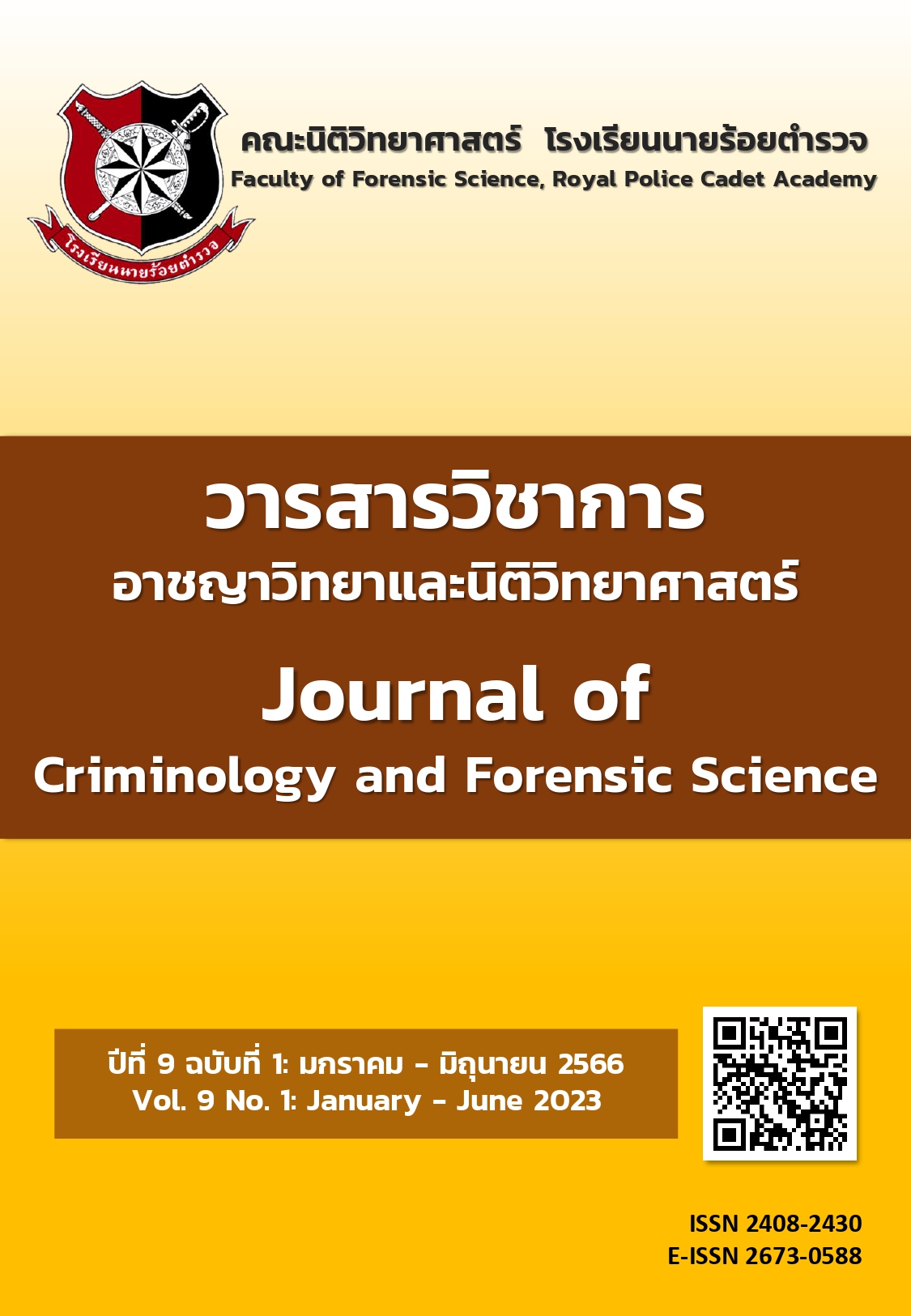การทดสอบความถูกต้องของวิธีวิเคราะห์ระดับแอลกอฮอล์ในเลือดโดยวิธีแก๊สโครมาโทกราฟี-เฮดสเปซแบบต่อคอลัมน์คู่
Main Article Content
บทคัดย่อ
การตรวจวิเคราะห์ระดับแอลกอฮอล์ในเลือดเป็นงานประจำในห้องปฏิบัติการพิษวิทยา การตรวจวิเคราะห์ซึ่งเป็นที่ยอมรับในความถูกต้องคือการตรวจวิเคราะห์ด้วยวิธีแก๊สโครมาโทกราฟี-เฮดสเปซ (Gas Chromatography-Headspace: GC-HS) โดยคอลัมน์คู่ (Dual column) และมีตัววัดสัญญาณชนิดเฟลมไอออไนเซชัน (Flame Ionization Detector: FID) การเปรียบเทียบเวลาในการแยกสาร (Retention Time: RT) จากคอลัมน์ทั้งสองจะช่วยให้สามารถระบุชนิดของสารได้อย่างถูกต้อง และสามารถคำนวณหาปริมาณของสารได้จากกราฟมาตรฐาน (Calibration curve) จากคอลัมน์ทั้งสองด้วย การศึกษานี้มีจุดมุ่งหมายเพื่อพัฒนาและทดสอบความถูกต้องของวิธีวิเคราะห์ระดับแอลกอฮอล์ในเลือดโดยใช้เครื่องมือแก๊สโครมาโทกราฟ ยี่ห้อเอจิเลนต์ (Agilent) รุ่น 7890B ต่อกับเครื่องเฮดสเปซ รุ่น 7697A และใช้คอลัมน์สำหรับตรวจแยกแอลกอฮอล์สองแบบ ได้แก่ ดีบี-บีเอซี1 (DB-BAC1) และดีบี-บีเอซี2 (DB-BAC2) โดยพบว่าเวลาในการแยกของเอทานอลในคอลัมน์ ดีบี-บีเอซี1 เท่ากับ 1.068 นาที ส่วนคอลัมน์ ดีบี-บีเอซี2 เท่ากับ 1.175 นาที โดยใช้เทอร์เชียรีบิวทานอล (Tert-butanol) เป็นสารมาตรฐานภายใน (Internal standard) ค่าความเป็นเส้นตรง (Range) อยู่ในช่วง 5.7 ถึง 376.02 มิลลิกรัมเปอร์เซ็นต์ (mg%) ค่าสัมประสิทธิ์สหสัมพันธ์ (R2) เท่ากับ 0.9999 ทั้งสองคอลัมน์ ร้อยละการคืนกลับ (%Recovery) อยู่ระหว่างร้อยละ 96.83 ถึง 105.76 ค่าต่ำสุดที่ตรวจพบได้ (Limit of Detection: LOD) เท่ากับ 5 มิลลิกรัมเปอร์เซ็นต์ และปริมาณต่ำสุดที่ตรวจวิเคราะห์ได้ (Limit of Quantitation: LOQ) เท่ากับ 7 มิลลิกรัมเปอร์เซ็นต์ ดังนั้น วิธีการตรวจวิเคราะห์ที่พัฒนาขึ้นนี้ สามารถใช้เป็นวิธีสำหรับตรวจวิเคราะห์หาระดับแอลกอฮอล์ในเลือดได้
Article Details

อนุญาตภายใต้เงื่อนไข Creative Commons Attribution-NonCommercial-NoDerivatives 4.0 International License.
เนื้อหาและข้อมูลในบทความที่ลงตีพิมพ์ใน วารสารวิชาการอาชญาวิทยาและนิติวิทยาศาสตร์ โรงเรียนนายร้อยตำรวจ ถิอว่าเป็นข้อคิดเห็นและความรั้บผิดชอบของผู้เขียนบทความโดยตรงซึ่งกองบรรณาธิการวารสาร ไม่จำเป็นต้องเห็นด้วยหรือรับผิดชอบใดๆ
บทความ ข้อมูล เนื้อหา รูปภาพ ฯลฯ ที่ได้รับการตีพิมพ์ใน วารสารวิชาการอาชญาวิทยาและนิติวิทยาศาสตร์ ถือว่าเป็นลิขสิทธิ์ของวารสาร วารสารวิชาการอาชญาวิทยาและนิติวิทยาศาสตร์ หากบุคคลหรือหน่วยงานใดต้องการนำทั้งหมดหรือส่วนหนึ่งส่วนใดไปเผยแพร่ต่อหรือเพื่อกระทำการใดๆ จะต้องได้รับอนุญาตเป็นลายลักษณ์อักษรจาก วารสารวิชาการอาชญาวิทยาและนิติวิทยาศาสตร์ ก่อนเท่านั้น
เอกสารอ้างอิง
Abercrombie, V. (2017). Improved Resolution and Peak Shape Performance for Determination of Blood Alcohol Concentration Using Agilent J&W DB-BAC1 Ultra Inert and DB-BAC2 Ultra Inert Columns. Retrieved January 16, 2019. from https://www.agilent.com/cs/library/applications/5991-8206EN.pdf
Behnoush, B., Bazmi, E., Akhgari, M., Nazari, S. S. H., and Iravani F. S. (2010). Evaluation of Ethanol and n-Propanol in Victims. Iranian Journal of Toxicology, 3(3), 311-316)
Bernal, E. (2012). Dertermination of Volatile Substances in Forensic Samples by Static Headspace Gas Chromatography. In B. Salih (Ed.), Gas Chromatography in Plant Science, Wine Technology, Toxicology and Some Specific Applications. IntechOpen.
Boswell, H., Dorman, F., and Lynam, K. (2013). Determine Blood Alcohol with Dual Column/Dual FID for Precision and Reproducibility. Retrieved January 16, 2019. from https://sem.com.tr/wp-content/uploads/Determine-blood-alcohol-with-dual-columndual-FID-for-precision-and-reproducibility.pdf
Boumba, V., Kourkoumelis, N., Ziavrou, K S., Fragkouli, K., and Vougiouklakis, T. (2012). Patterns of the most abundant volatile detected in post-mortem blood. Romanian Society of Legal Medicine, 20, 147-154.
Boumba, V., Ziavron. K. S., and Vougiouklakis, T. (2008). Biochemical pathways generating post-mortem volatile compounds co-detected during forensic ethanol analyses. Forensic Science International, 174, 133-151.
Canfield, D. V., Smith, M. D., Adam, H. J., and Houston, E. R. (1998). Selection of an Internal Standard for Postmortem ethanol Analysis. Federal Aviation Administration. U.S. Department of Transportation.
Jones, A. W. (1996). Measuring Alcohol in Blood and Breath for Forensic Purposes - A Historical Review. Forensic Science Review, 8(1), 13-44.
Jumlongkul, A. (2016). Ethyl alcohol in forensic aspects. Chulalongkorn Medical Journal, 60(3), 283-296. (In Thai).
Kongmebhol, V. (1986). The diagnosis of drinkers. Chulalongkorn Medical Journal, 30(8), 715-724. (In Thai).
Ningnoi, T. (2006). A Practical Guide for Single Laboratory Method Validation of Chemical Methods. 1st Edition. Nonthaburi: Department of Medical Sciences. (In Thai).
Okorocha, O. (2014). Flawed Blood Tests: The DUI Exception to Admissible Evidence. Journal of Science and Technology, 24(1), 211-231.
Sharp, M. E. (2001). A Comprehensive Screen for Volatile Organic Compounds in Biological Fluids. Journal of Analytical Toxicology, 25, 631-636.
Sreeganjant, P. (2019). A Comparative Study of the Alcohol Concentration in Vitreous Humor and Blood with Headspace Gas Chromatography. Journal of Criminology and Forensic Science, 6(1), 48-58. (In Thai).


